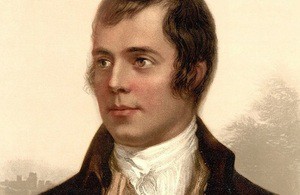25th January 2015 Skopje, North Macedonia
Burns’ night through my eyes
Burns’ night is a big deal in Scotland. I come from the west of Scotland, just up the coast from where Robert Burns lived and worked in Ayrshire. As a child, I remember in the middle of every dreich (cold, rainy and grey) month of January, my parents, aunts & uncles etc, would get dressed up to go to a ‘Burns Supper’. I never understood what the fuss was, as for many years I thought they were going to have a ‘Burnt supper’! How wrong I was. Only as I became a teenager and started to read poetry as part of our school English literature classes did I realise how intrinsic Robert Burns is to Scottish culture, and history. And when I finally attended a Burns’ supper myself in my 20s, in Denmark, I could see the attraction – really tasty food, in a sociable setting, with good friends, and celebrating family life.
On 25 January Scots around the world celebrate the life and works of Robert Burns. The first Burns’ supper took place on July 21, the anniversary of his death, in Ayrshire, Scotland, in the late 1700s. The date that we celebrate the life of Burns was later changed to January 25, his birthday.
Most of you will know that the key components of any Burns’ night are speeches, poetry readings and the infamous haggis. But it is much more than that, and it is a really good way for communities to get together. Sometimes they’re very informal family meals, and other times they’re posh events with hundreds in attendance, set running order, dancing, and a piper playing the bagpipes to ‘pipe in’ the haggis, which is then dissected with a sword (while the poem ‘To a Haggis’ is read).
Sometimes, it’s difficult to get Haggis if you’re not in the UK, and it’s not always to everyone’s taste (it is made up of sheep’s heart, lungs, and kidneys with spiced oatmeal). I like a little bit of it, but I particularly like vegetarian haggis. There are lots of other Scottish recipes to try out instead – here are a few ideas below:
Starter
Main course
- Haggis, neeps & tatties (haggis with mashed turnip and potatoes)
- Steak pie (a beef pie cooked slowly in the oven with a puff pastry lid)
- Cullen Skink (a smoked fish and potato broth, similar to a ‘Ribina chorba’)
- Vegetarian haggis (easily made at home with all the ingredients readily available in Macedonia!)
For Dessert….
Burns also wrote about ‘the land of cakes’ and there are indeed lots of options for this course that would be perfectly adequate (a favourite phrase from my grandfather, and then father who used it to mean something was particularly delicious!) Typsy Laird (a Scottish sherry trifle); or Cranachan (a creamy cold dessert, layered with oatmeal and raspberries).
Cheeseboard with oatcakes (Scotland, like the rest of the UK, has lots of lovely cheeses often named after the places they’re from. Some are now available in Macedonia like Scottish Cheddar, Double Gloucester, Red Leicester).
And of course all washed down by Scotland’s national drink – whisky!
During the event, there is something called ‘The immortal memory’ when the main speaker talks about the life of Robert Burns, and that’s often followed by a poem or a song like ‘My love is like a red red rose.’ Then there is an infamous ‘Toast to the Lassies’, (the Scottish word for a girl is a lass), which is meant to praise the role of women in today’s society. Usually this is accompanied by using quotes from Burns poetry, and it’s often funny to hear how poems wrote centuries ago still can still apply today.
At the end of the evening, it’s customary to sing another of Burns famous songs – Auld Lang Syne (For Old times’ sake), a song about friendship, and communities, that has endured centuries, and whose meaning stays the same today as when it was written.
Christine Winterburn
Deputy Head of Mission, British Embassy Skopje

Odlichen tekst Christine, jas seushte se sekjavam na “haggis”. Pozdrav, Sonja x